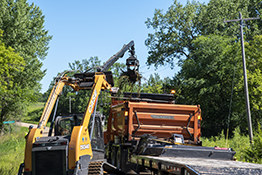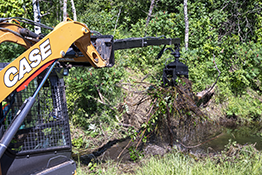
Culvert cleaning crews in Otter Tail County have spent many hours manually shoveling out clogged culverts, which can be a dirty, dangerous, and labor-intensive job. The department’s skid steer attachment—the Otter Claw—has changed all that. The county received funding from the Local Operational Research Assistance (OPERA) Program to enhance the device, and an OPERA video is now available.
Watch a video of Otter Claw in action
Otter Tail County highway maintenance workers Brody Bakken and Dennis Bosek developed the Otter Claw to save time and enhance worker safety when cleaning out culverts. The skid steer attachment can extend up to 15 feet, allowing the operator to easily and safely remove large amounts of debris in as little as 10 minutes from culverts and ditches, around bridges, and in other previously hard-to-reach locations.
The original design of the Otter Claw, which taps into the hydraulic system of the skid steer, included a rotatable grapple claw fabricated from exhausted steel plow cutting edges. Workers found its effectiveness somewhat limited by a repeated need to manually adjust the orientation of the claw using a removable pin to set a new position.
To improve the strength, durability, and ease of use of the Otter Claw attachment, the Otter Tail County Highway Department sought and received a $6,000 grant through the Local OPERA Program for an omnidirectional hydraulic swivel head.
The team broadened the functionality of the Otter Claw beyond the grapple claw by developing additional hydraulic attachments for cleaning culverts, such as expandable paddle-like shovel heads and flat scraping heads to fit culverts of different sizes. As team members refined these implements, they found it worked better to mount the culvert cleaning attachment at a different angle and position on its own base plate, which easily connects to the skid steer like the grapple claw attachment.

Maintenance workers often find culverts obstructed by tree branches, mud, rocks, plywood, and other garbage placed inside of culverts by animals or people. Once the Otter Claw has cleaned several feet of debris from each end of a culvert, it is often necessary to apply a high-pressure blast of water through the full length of the culvert with a jetter to fully restore the proper flow of stormwater.
The Otter Claw also can be used to place riprap alongside bridges, culverts, and roads adjacent to bodies of water to prevent erosion and other damage. Other uses include placing culvert sections during construction and handling storm-damaged trees. Using the claw to hold downed trees or logs makes it easier and safer to cut and load large pieces for removal.
The Local OPERA Program, an LRRB program administered by MnLTAP, encourages maintenance employees from all cities and counties to get involved in operational, “hands-on” research.
—Michael McCarthy, MnLTAP editor